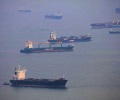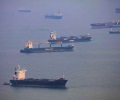

Contrary to initial expectations and despite the thrust on cleaner marine fuels due to the International Maritime Organization’s global low sulfur mandate, the high sulfur bunker fuel market has remained strong as scrubbing remains a favorable option, global research and consulting company BLUE Insight’s director Adrian Tolson said.
Very low sulfur fuel oil currently represents 60%-65% of global bunker demand and sufficient supply exists. But VLSFO demand will likely drop as alternatives enter the market and additional scrubbers will be installed, Tolson said in a pre-recorded video for the 37th Asia Pacific Petroleum Conference, or APPEC 2021, organized by S&P Global Platts from Sept. 27-29.
When IMO 2020 came up, shipowners had two routes to compliance — install scrubbing technology and continue to buy HSFO, or use compliant VLSFO fuel in main engines.
The debate in shipping was actually quite heated and controversial, with shipowners holding two very divergent views, Tolson said.
One view was that scrubber was the best choice as HSFO would be much cheaper and refiners were not likely to invest in upgrading to VLSFO production.
The other was that many shipowners felt that there was an obligation on the suppliers and refiners to ensure that shipowners could find high quality low-priced compliant VLSFO, and it was not the shipowner’s responsibility to have a “mini-refinery” on their vessel, he added.
“Despite the pre-2020 Hi-5 spread, uncertainty regarding the Hi-5 spread and lack of liquidity on the forward curve limited major upgrading and investment decisions prior to 2020,” Tolson said.
“The scrubber decision was a little bit easier because worried refiners and suppliers were willing to commit to medium test formula-based contracts for potentially depressed HSFO,” he said, adding that scrubbers continue to win over refinery desulfurization and upgrading projects.
In Singapore, the world’s largest bunkering port, Tolson noted that HSFO demand has remained strong. This is also reflected in other ports worldwide although there is a “heavier demand” for HSFO in Singapore compared to smaller ports because bigger ships come to Singapore, he said.
In August, Singapore’s sales of high sulfur bunker fuel, which includes 180 CST, 380 CST and 500 CST bunker fuel, were up 2.7% year on year to 1.057 million mt, or 25.9% of the total sales in August, up from 24.6% a year earlier, latest data from the Maritime and Port Authority of Singapore showed.
In general, HSFO has reduced the need for low sulfur bunkers as the market is taking advantage of the cheaper cost of scrubbing, Tolson said, adding that the key Hi-5 spread will likely stay narrow for the foreseeable future.
In Singapore, this spread averaged $298.90/mt in January 2020 as the market transitioned to the IMO 2020 mandate, Platts data showed. It narrowed to average as low as $60.32/mt in September 2020, but recovered to average $103.33/mt in January 2021, according to Platts data. On a monthly basis, the spread has remained mostly over $100/mt on an average so far this year and averaged $82.59/mt from Sept. 1-27.
Scrubbing, a rewarding solution
Looking at a Neopanamax open loop scrubber payback scenario for a 15,000-16,000 TEU vessel, it is still a $6.5 million investment and there is a certain amount of time lost in installing scrubbers, Tolson said.
If one looks at the period around February 2020, it took less than 1 year to payback an investment in scrubbers then. The payback now is about 3 years but it is still an attractive payback, Tolson said.
The argument of putting a scrubber on board and burning HSFO on bigger ships and on newbuilds is even more compelling, Tolson said.
“Newbuilds aren’t retrofits. You can build a scrubber into a new vessel that costs much less than you can by retrofitting… So, in one and a half years you can have a payback on any scrubber investment, Tolson said.
It is also useful to carry out a cost comparison between upgrading projects and scrubbing. Upgrading projects can take place in a refinery or on a standalone basis and the cost of these depends on size — capacity throughput, location and how much needs to be built, Tolson said.
“I’m assuming here 2 options where a project to create a 50,000 b/d processing unit would cost you somewhere between $500 million to a $1 billion … and I’m assuming a 7 year payback on both the scrubber and refinery upgrade or the standalone unit,” Tolson said.
“What you can see from this is that a scrubber retrofit on container ships is about 50%-35% of the cost of upgrading projects, which makes upgrading high sulfur fuel oil to low sulfur highly uncompetitive for the majority of large ships,” Tolson said.
So, upgrading is not justified from a pricing perspective, Tolson said, noting that scrubbing emerged as the winner in the processing versus scrubbing debate.
Source: Platts